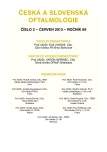The Importance of Angle Kappa for Centration of Multifocal Intraocular Lenses
Authors:
M. Karhanová 1; K. Marešová 1; F. Pluháček 2; P. Mlčák 1; O. Vláčil 1; M. Šín 1
Authors‘ workplace:
Oční klinika FN a LF UP, Olomouc, přednosta prof. doc. MUDr. Jiří Řehák, CSc., FEBO
1; Katedra optiky PřF UP Olomouc, vedoucí prof. RNDr. Zdeněk Hradil, CSc.
2
Published in:
Čes. a slov. Oftal., 69, 2013, No. 2, p. 64-68
Category:
Original Article
Prezentováno na IX. mezinárodním kongresu ČSRKCH v Ostravě, 21. 5. 2011 a na 16. ESCRS Winter Meetingu v Praze, 3. – 5. 2. 2012
Overview
Purpose:
To evaluate patient satisfaction with multifocal intraocular lens (MIOL) implants (AcrySof Restor) in relation to the size of angle kappa and precise centration of the MIOL.
Methods:
Fifty-two eyes of 26 patients were included in this study. All patients underwent bilateral phacoemulsification and multifocal intraocular lens implantation (AcrySof Restor) from January 2008 to April 2010. Preoperative and postoperative examinations included slit lamp biomicroscopy, near and distance uncorrected visual acuity (UCVA) and best-corrected visual acuity (BCVA), contrast sensitivity and measurement of angle kappa. Precise centration of the IOL with respect to the centre of the pupil was evaluated postoperatively. Subjective photic phenomena were evaluated separately for each eye and the patients were asked to compare the perception between the right and left eye.
Results:
Angle kappa was positive in all cases, ranging from +1° to +7°. The mean angle kappa was 2.78° and 2.10° in the right and left eye, respectively. The IOL was centred exactly to the centre of the pupil in 40 eyes. In twelve eyes there was a slight decentration of the IOL (3 nasal, 4 temporal, 2 superotemporal, 2 superior, 1 inferior). Different subjective perception of photic phenomena between the two eyes was recorded only in five patients. All these patients were among those with a decentred IOL. Temporal and superotemporal decentration of the IOL caused pronounced photic phenomena in five cases – in four cases there was a greater angle kappa of +3° to +4°. In one case of temporal decentration and a small angle kappa (+1°), the patient failed to observe a difference between both eyes. In the cases of inferior, superior and nasal decentration of the IOL, no difference between both eyes was seen.
Conclusion:
According to our results, temporal decentration of the IOL is associated with the greatest risk in multifocal IOL implantation, particularly in cases with a higher angle kappa. An evaluation of angle kappa should be a part of preoperative examination before MIOL implantation. Patients with a high angle kappa should be excluded because of a higher risk of postoperative photic phenomena.
Key words:
angle kappa, multifocal intraocular lens, photic phenomena
Sources
1. Agarwal, A., Prakash, G., Jacob, S. et al.: Can uncompensated higher order aberration profile, or aberropia be responsible for subnormal best corrected vision and pseudo-amblyopia. Med Hypotheses, 2009; 72: 574–577.
2. Agarwal, A., Jacob, S.: Aberropia: a new refractive entity. J Cataract Refract surf, 2007; 33: 1935–1836.
3. Basmak, H., Sahin, A, Yildirim, N. et al.: The angle kappa in strabismic individuals. Strabismus, 2007; 15: 193–196.
4. Basmak, H., Sahin, A., Yildirim, N. et al.: Measurement of angle kappa with synoptophore and Orbscan II in a normal population. J Cataract Refract Surg, 2007; 23: 456–460.
5. Chan, C.C.K., Boxer Wachler, S.: Centration analysis of ablation over the coaxial light reflex for hyperopic LASIK. J Cataract Refract Surg, 2006; 22: 467–471.
6. DeVries, N.E., Webers, C.A.B., Touwslager, W.R.H. et al.: Dissatisfaction after implantation of multifocal intraocular lenses. J Cataract Refract Surg, 2011; 37: 859-865.
7. Divišová, G.: Strabismus, Avicenum Praha, 1979: 140.
8. Hashemi, H., KhabazKhoob, M., Yazdani, K. et al.: Distribution of angle kappa measurements with Orbscan II in a population-based survey. J Cataract Refract Surg, 2010; 26: 966–971.
9. Kottler, U.B., Tehrani, M., Dick, B.: Impact of the line of sight on toric phakic intraocular lenses for hyperopia. J Cataract Refract Surg, 2004; 30: 1799–1801.
10. Marešová, K., Mlčák, P., Vláčil, O.: Výsledky operací katarakty s implantací Acrysof ReSTOR SN6AD3. Čes. a slov. Oftal., 2010; 1: 26–28.
11. Nepomuceno, R.L., Boxer Wachler, B.S., Kim, J.M. et al.: Laser in situ keratomileusis for hyperopia with the LADARVision 4000 with centration on the coaxially sighted corneal light reflex. J Cataract Refract Surg, 2004; 30: 1281–1286.
12. Prakash, G., Prakash, D.R., Agarwal, A. et al.: Predictive factor and angle kappa analysis for visual satisfactions in patients with multifocal IOL implantation. Eye, 2011; 25: 1187-1193.
13. Walkow, L., Klemen, U.M.: Patient satisfaction after implantation of diffractive designed multifocal intraocular lenses in dependence on objective parameters. Graefes Arch Clin Exp Ophthalmol, 2001; 239: 683-687.
14. Woodward, M.A., Randleman, J.B., Stulting, R.D.: Dissatisfaction after multifocal intraocular lens implantation. J Cataract Refract Surg, 2009; 3: 992-997.
15. Tabernero, J., Benito, A., Alcón, E. et al.: Mechanism of compensation of abberations in the human eye. J Opt Soc Am A Opt Image Sci Vis, 2007; 24(10): 3274–3283.
Labels
OphthalmologyArticle was published in
Czech and Slovak Ophthalmology

2013 Issue 2
Most read in this issue
- Myopia or Hyperopia?
- Vogt-Koyanagi-Harada Syndrome in Children – a Case Report
- The Importance of Angle Kappa for Centration of Multifocal Intraocular Lenses
- Contraception and Ocular Thromboembolic Episodes – A Case Report
